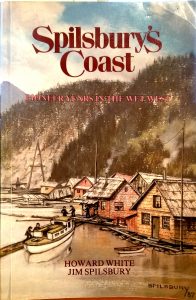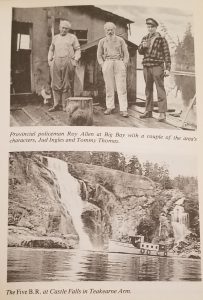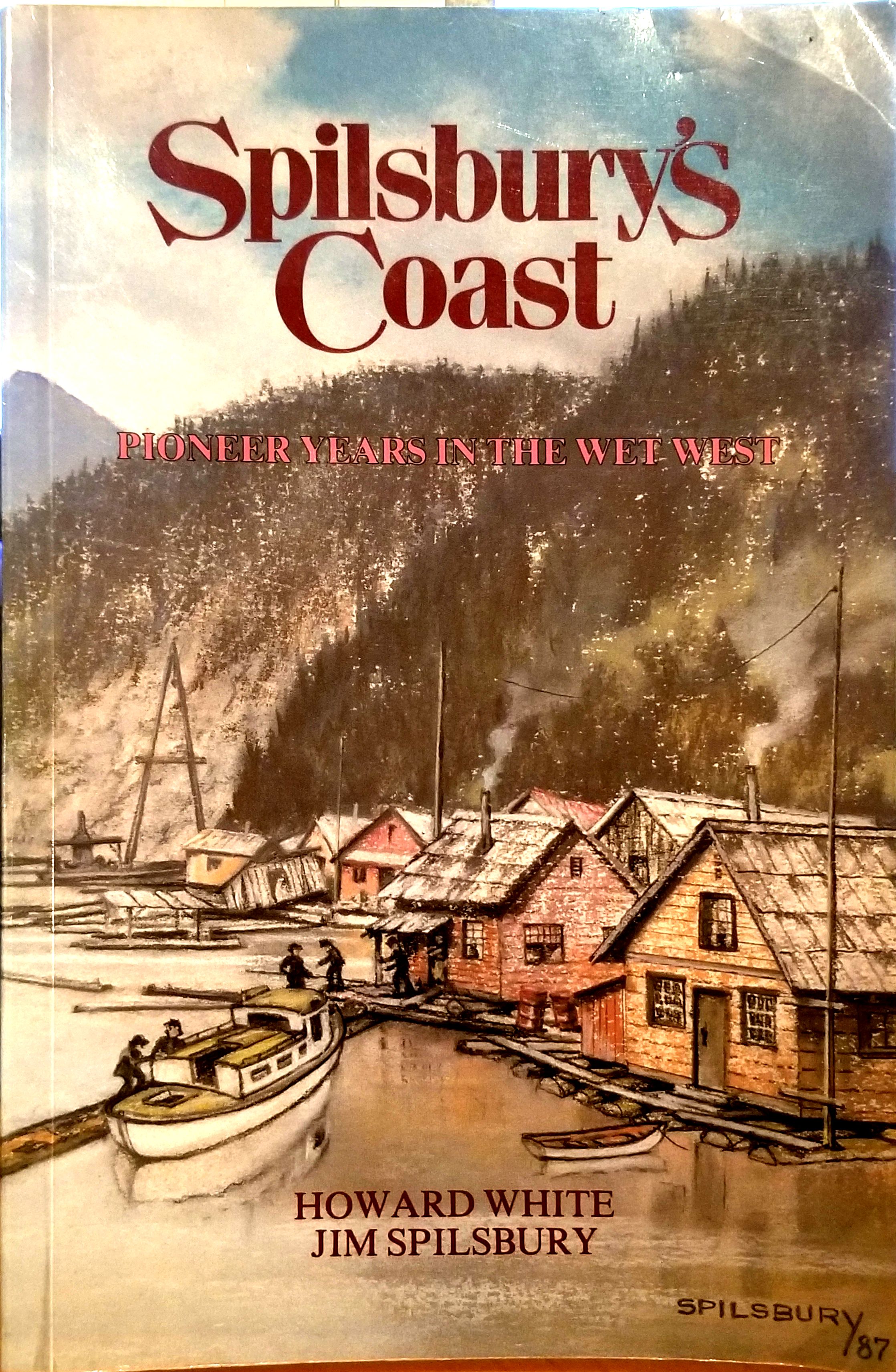Spilsbury’s Coast: A Review.
Something a little bit different here that may be of interest to club members; I just finished reading “Spilsbury’s Coast” and wanted to share somewhat of a mini-book review of a very ‘ham-related’ book.
I bought the book because of my interest in shipping and local history, though I found that it’s actually a great story of how early life on coastal British Columbia was shaped by radio. The book is something of a biography, but more so a collection of stories and adventures of Jim Spilsbury over an 80-year period. Jim was the main repairman and supplier of radio equipment to coastal BC since virtually the very beginning of radio. Jim’s traveling business covered the BC coast from Vancouver to as far north as the northern tip of Vancouver Island and every inlet up and down. He supplied logging camps and vessels with their “wireless” as it was then known. Later, when radio broadcasting caught on, he did a booming business supplying radio sets as entertainment fixtures in private residences on the coast.
In later years, Jim was joined in his travels by his wife and eventually their infant son plying his trade. The boat did triple duty as a home, repair shop and equipment showroom. Later in life, Jim expanded his booming business to float planes and that business would grow into Canada’s third largest airline. Jim was both lucky and a shrewd businessman.
Of even greater interest to those in Maple Ridge, Jim was a local son, as his family initially settled in Whonnock when they immigrated to BC.
Jim was born in 1905 and in the early part of the 19th century, wireless was virtually unheard of by most residents of coastal BC. Except for those that ventured aboard large ocean-going vessels whose wireless shacks would relay Morse code to coastal stations announcing important messages and their coming and going. Jim recalls being enthralled in 1912 at hearing how the Titanic had sent an SOS signal over wireless (the first ever) and marveling at the technology that allowed this. At the time, a wireless operator was a good job on these large ships making $110 a month and the operator usually held the nickname “Sparks” stemming from how the radios operated. Jim describes his first encounter with wireless while on a CPR steam ship to Victoria:
“Near the purser’s office was the wireless office. The CPR was equipped with wireless then. My mother couldn’t get me away from the door. The operator was sending off traffic reports or something. To Point Grey in those days. What he was using, as I know now, was a big rotary spark gap, probably the old one-kilowatt deal. They had a bank of Leyden jars and this spark-gap- this was a pinwheel rotating with electrodes just about touching but not quite, and the current would jump that and spark. They drove it at five hundred cycles a second- a nice tone to copy. The receivers were just a crystal and a cat’s whisker and a tuning coil. And a pair of headphones. It had a range, with a good antenna, of fifty miles or more. It would cover Vancouver to Victoria. There was VAB in Vancouver and VAK in Victoria and the ship would be VGRB or something like that. Anyway, I was standing outside the door and the operator was using the key, sending messages out over the ether, and I couldn’t pull myself away. From the start it had a special attraction. The ozone smell from the sparks came to be the smell of adventure for me.”
 As a young man, Jim began reading electrical engineering textbooks. He bought the ten-volume set of Audel’s Electrical Guides and Dictionary. At the time, in 1920, voice broadcasting didn’t exist and while there were hams, they were only using Morse back then. Jim describes building his own telegraph to a nearby friend’s house:
As a young man, Jim began reading electrical engineering textbooks. He bought the ten-volume set of Audel’s Electrical Guides and Dictionary. At the time, in 1920, voice broadcasting didn’t exist and while there were hams, they were only using Morse back then. Jim describes building his own telegraph to a nearby friend’s house:
“That’s when I decided to build a telegraph line, from my house to Jimmy’s. He lived down the other end of the settlement a little over two thousand feet from me. I remember the distance because I had to order the wire. I got galvanized fence wire. It only cost about four dollars. I put cut-off beerbottle tops on wooden pegs on the trees… I made relays out of old Model T generator cutouts. I probably got directions from some magazine article. We hooked up a buzzer, and for power we went over to Frank Osborne’s machine shop in Lund and got old Number Six dry cells thrown out by the fishermen… Every night we’d sit down for an hour or so and talk backwards and forwards on our telegraph line until we got our code speed up.”
Later while living on Savary Island, Jim would read the Montreal Star, a national newspaper which had a column devoted to wireless technology. It often had how-to guides on building your own equipment and from that Jim learned to build a crude wireless receiver. He described it:
“I got a crystal, made up a cat’s whisker, and for the rest all I needed was bellwire and a circular oatmeal carton to wind it all on. I made this thing and eventually I could hear boats. Morse Code. I could hear Estevan Point, I could hear Triangle Island – this was just before the isolation and fierce winds there caused the station to be abandoned in 1920… So I couldn’t go to sea and become a ship’s radio operator but I could stay on Savary and listen to the deepsea ships coming in, talking to the shore stations giving their positions, their ETAs, and reeling off long lists of stuff. That normally goes at twenty words a minute and I finally got so I could copy it pretty solid.”
A great moment, probably a major turning point in Jim’s life, was when he was tuning through the airwaves and first heard a broadcast that wasn’t just Morse code, it was something far more intriguing. The emotions he describes at that moment might be akin to the excitement many amateur radio operators have once experienced:
“It had weak reception but Jimmy climbed a tree for me and got a huge antenna up. I’d stay up half the night after everybody had gone to bed trying to tune in new places, and one night I couldn’t believe my ears: I kept jiggling, jiggling, trying to bring it in and- yes, music! MUSIC!”
In 1922, Jim had heard about radio broadcasting but it was something experienced only to those in a few far-away cities. That night, Jim recalls listening to KPO radio in San Francisco broadcast a live orchestra from the Fairmont Hotel. As Jim put it, he darn near died and immediately awakened his family to also revel in the splendor of music being broadcast over the air. Word spread fast and the next night, every resident of the island joined the Spilsbury family to also hear this miracle of sound that was being played live, from so far away. Everybody that heard about it wanted it in their own house and asked Jim to build him the same receiver. By 1924, Jim was building eight-tube superhetrodyne receivers and selling them throughout the area. A Vancouver doctor even traveled to Savary to buy a receiver from Jim. It would soon become a popular domestic pastime to listen to radio broadcasts and Jim would also become popular as the supplier of the hardware.
Deeply inspired by the possibilities of radio, Jim sought out every bit of radio literature he could get his hands on and soaked up every bit of radio knowledge available. His love for radio had already spurned him into the business, but it was his love for a woman that really grew the business. Jim fell for a wealthy art student that visited Savary Island in the summer of 1932 as part of a Vancouver art school excursion. The two hit it off, however her well-to-do family wouldn’t permit a relationship with anyone earning less than $500 a month, an astronomical sum then, even before the depression years.
It was foolish to even try, but Jim was stubborn. He worked tirelessly attempting to meet the impossible salary goal, selling and repairing radios everywhere a boat would carry him. A children’s fairytale happy-ending would have the hero working night and day, earning the required sum and happily-ever-after. Jim never even came close to earning that amount, however. But somehow he won over the girl and her family, eventually marrying her.
Jim describes in great detail some of his products, which ranged from utilitarian to extravagant. He described an especially elaborate set that sold for $220 in the darkest days of the depression: “It was an eight-tube RCA Victor with all bands, standard and short wave, in a luxurious console cabinet the size of a small refrigerator… It took only a couple hours for me to unpack the set, erect an aerial, hook up the batteries, and show him how to operate it on both standard and short wave. Among the short wave stations, BBC London was coming in like a local. We were miles away from the nearest source of electrical interference, and domestic stations were as clear as you ever heard them The set’s big speaker set that cavernous room ringing like a concert hall. Just that simply, the remote interior of Read Island had been made a part of the modern world. There were times like this when the wonder of radio science struck me anew…”
Jim also was a licensed ham operator and tells stories of how hams helped in major emergencies, including the Alaska earthquake of 1964 and the Edmonton tornado of 1987. One of his more detailed first hand accounts was of a major storm to his western Canada in 1935. It was one of the worst ice storms in history, crippling the west for weeks. During the storm, two cross-country passenger trains were lost without a trace. One was derailed a few miles from Vernon, BC and was able to get word of its situation to a CPR agent in that town. However, the town was cut-off from the rest of the world so worried families and the company had no contact. A ham operator in Vernon, VE5KN was someone Jim spoke with almost every night. VE5KN tried to relay a message to Vancouver but due to electrical noise, could not get through. Jim tried to relay the message, but he also couldn’t, however a ham in Parksville (VE5BL) could hear Jim and was able to relay the message to VE5AS in Vancouver. Once established, open communication flowed back and forth between the train, the four hams and the head office in Vancouver. For three days, the communications flowed and Jim handled 340 messages, at one point going without sleep for 40 straight hours to facilitate the communications.
Jim’s business interests later included Spilsbury & Hepburn Ltd, a major manufacturer of “radio telephones”. These radio telephones that Jim manufactured would become one of the most well-known and popular radio-telephones in the country. Jim describes the setup of a radio telephone at a logging camp in a remote bay near the northern end of Vancouver Island:
“…I managed to talk the owners into taking this fifty-watt radio telephone. Up to that time people didn’t think radio would work so far from Vancouver, and I wasn’t sure myself, but I felt I would have a chance with a high enough aerial… The masts had to be raised right in the middle of this muddle so as to give the guy lines sufficient spread. The longest masts they could find were 116-foot yellow cedar poles, since there was no Douglas fir in that country. They were so limber they both broke during the raising and had to be spliced, so then they stood only 105 feet high. It wasn’t what I wanted, but I prayed under my breath it would pull in enough of a signal to satisfy them. While a crew of men fought to get the masts solid, I went to work wiring up the set. I stretched the aerial leads out of the office and draped them over the railing beside the walkway ready to be strung up as soon as the masts were ready. Then I went back in to turn on the set. I just wanted to make sure it was ready and didn’t expect anything to happen, but to my amazement sound just boomed out of it. Vancouver was coming in like a freight train, and the only aerial it had were the leads draped over the railing! …What I didn’t know at that time was that the height of the aerial didn’t matter as much as the angle it formed with the part of the sky that reflected the signal. The signal went up from the transmitter in Vancouver, bounced off the atmospheric stratum radio people called the heavy side layer, and then down to the aerial in Seymour Inlet – at an angle the high-level aerial missed but the low one just nicely intercepted. Another thing I would come to realize as I set up more stations on floatcamps was that the salt water acted as a very powerful signal reflector, gathering and strengthening the signal when the aerial was placed closer to it. Nobody could tell me any of this because nobody knew. I had to find it all out for myself.”
Packed with wonderful historical photos, Spilsbury’s Coast is 190 pages of great stories, maps, letters home to the parents, adventure and a lot of British Columbia history, particularly related to radio. If you’re an amateur radio enthusiast, this former BC best-seller is sure to please you. “Spilsbury’s Coast, Pioneer Years in the Wet West” was written by Howard White and Jim Spilsbury, and is published by Harbour Publishing, Madeira Park, BC. ISBN # 1-55017-046-5.

Hey, you get an A+ on your book report young man! I read this book years ago and thoroughly enjoyed it. Anyone with a love of maritime history, airplanes and radio should definitely give this wonderful story a read.
Thanks Paul! 🙂